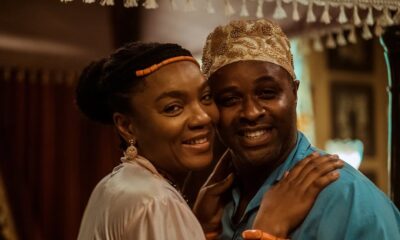Features
Sahndra Fon Dufe: My Experience at The 2024 Marist and Guzangs Fashion Exhibit
As Sonia hand-dyed fabrics with marigold flowers, creating scarves from campus-grown sustainable materials., I realised this wasn’t just fashion; this was community. This was culture.

Sahndra Fon Dufe Okeowo
It’s Fashion Week in New York City, yet we found ourselves in the charming woods of Poughkeepsie where Marist College is located, surrounded by local breweries and air so crisp it felt like a creative epiphany waiting to happen. The alluring big windows welcoming all the natural light made wonder, whoever designed this space must have had their soul dipped in art.
The two-day event was a whirlwind of fashion, culture and a lot of deep-thinking conversations. In full swing, we dived into the “Alternative Realities: Modern and Contemporary African Fashion, A View from the Continent” exhibition. Curated by the Cameroonian-American fashionpreneur and founder of Guzangs, Idelle Taye and Nigerian architect Kelechi Odu, in partnership with Marist, it was the ultimate intersection of culture, style and heritage. Guzangs was here to break boundaries, merge sustainability with artistry and showcase the raw power of African heritage in fashion.
The Making of a Modern African Fashion Exhibit
If you’ve ever seen HBO’s Sex and the City, picture me channelling my inner Carrie Bradshaw. I was sitting there, pen in hand, soaking in the magic happening in the Textile Room at Marist’s historic Steel Plant. Two hundred years of history buzzed in the air, curated by Sonia Roy who has been leading Marist’s fashion department for over 20 years. Her movement throughout the event exhibited how passionate she is about nurturing fashion talent from NYC to Africa and leading the partnership with Guzangs. As Sonia hand-dyed fabrics with marigold flowers, creating scarves from campus-grown sustainable materials., I realised this wasn’t just fashion; this was community. This was culture.

I had quite an experience on Day 1. I felt like a queen in my pleated pink cloak-sleeve dress, channelling my inner Khaleesi. Everyone kept asking if I was a speaker, but I just replied, “No, but my dress is doing all the talking.” That expresses how excited I was about the day. The panel, led by Marist Dean Jacqueline Reich, explored the Hudson River, with sustainability and African fashion at the forefront. Kelechi sparked a juicy debate on borrowing fashion ideas from other regions, while Idelle and Maliz Mahop contributed by reiterating how clothes can either reflect external influences or reclaim personal stories. I resonate with the session because I enjoy expressing my identity through fashion, whether it’s my natural hair, braids, or a chic wig. Day 1 served as a creative appetizer for what was about to unfold.
Day 2 – The Exhibit
By Day 2, I knew it was time to show up and show out. I wore my stunning white ensemble by Cameroonian designer Sulet Noir, serving sophistication on a platter. We started Day 2 as we moved to the Steel Plant, and the energy shifted. Gavin Webb and his Kente Drums & Dance Group serenaded us with traditional Ghanaian drums. I couldn’t help but move along with the rhythm. The exhibit was exceptional. The textures and fabrics—some bold and vibrant, others soft and intricate—were more than just fashion. They demanded attention, practically commanding to be touched and admired. It wasn’t just an exhibit—it was an immersive experience. You didn’t just look at the pieces, you felt them, collaborated with them, and, if I’m being real, lived in them.

Africa’s Designers are Moving and Shaking Things Up
The exhibition showcased an impressive display of African fashion, with each designer contributing a unique element to the future of the industry. There were 14 visionary creatives, and some of the standout pieces for me were Gaëtan’s SHEMA, Kusi Kubi’s Palmwine Icecream, and Florentina Agu’s Hertunba. Florentina’s ruffle dress was particularly striking, with its vibrant colours and textures. Shema’s handcrafted jacket was also impressive. The focus on sustainability in fashion was evident, reflecting the growing eco-conscious movement shaping contemporary African design.
Then came Lagos Space Programme’s beaded headdress that flowed so intricate and delicate it could’ve been alive — a true homage to heritage. Nkwo’s designs were a masterclass stitch in how eco-friendly fashion could still snatch waists and turn heads. And of course, Palmwine Icecream’s daring goat-hide two-piece ate. Eddy Patrick Muyishime’s metallic Afrofuturist gowns were futuristic and bold in every stitch. I felt like Katniss Everdeen standing next to his iconic orange dress, waiting for it to burst into flames like in the Hunger Games.
Beyond the stunning garments, the exhibit also featured captivating photography by talents like Bade Fuwa and cutting-edge designs by Zingha Foma, a fellow Cameroonian. It was a striking fusion of texture, history, and innovation, leaving me in awe of the potential within African fashion.

After the event, it was clear that this was more than just a fashion exhibit. It was a celebration of African designers who are making a significant impact on the industry with their bold and visionary designs. Their work defies categorisation. With African designers weaving ethics and sustainability into every stitch, Guzangs is rewriting the rules of African fashion, bridging local talent with global opportunities. I’m incredibly inspired by their growing impact on fashion and sustainability.
Before leaving Poughkeepsie, I had one final adventure: a delightful dinner hosted by Dean Jackie and Edward Antonio. The food was so good that it almost made me forget how many times I mispronounced Poughkeepsie. The school tour was a highlight. Seeing wide-eyed, hopeful students exploring their first looks and preparing collections gave me a glimpse into the future of fashion. Marist’s campus, rich with history and artistic vibes, gave me Bridgerton modiste vibes as I watched the creative process unfold. These students? Future Vera Wangs in the making.





















